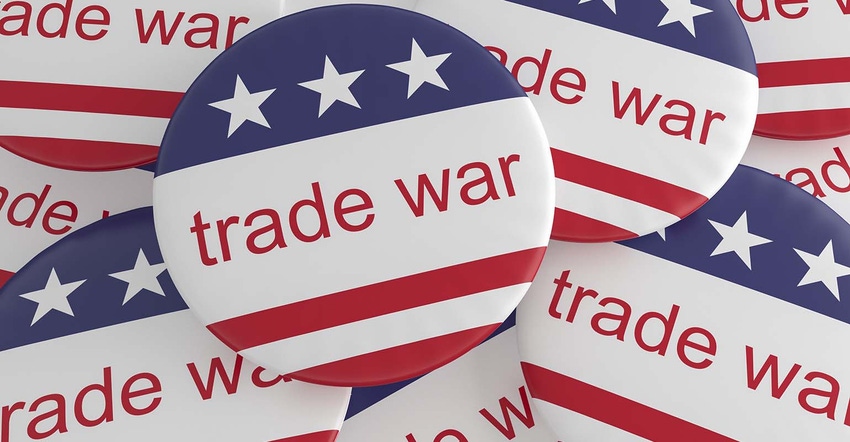
By the time you read this, maybe the China-U.S. trade war will be settled.
That would be amazing, yes. Unfortunately, history says even if the battle is over, the post-war impacts will linger long after the dust has settled.
That $12 billion aid package from Uncle Sam includes a couple hundred million for ‘trade promotion,’ but USDA may as well try to scrape together another $12 billion for that task. Fixing this damage won’t be easy, and it won’t come fast.
Being labeled an unreliable supplier is akin to being picked last for the baseball team. U.S. agriculture prides itself in its ability to “feed the world.” But being labeled an unreliable supplier? It’s embarrassing. It’s like Superman just opened a Christmas present and found kryptonite.
It takes years to build those trade relationships, and one policy move to undo all that good work.
I understand the president’s rationale. Former presidents have all agreed that China was cheating and should be held accountable for being bad actors on the trade front. But none ever had the gumption to put real pressure on them in the form of tariffs. This was bold.
Long before he was president, Trump argued U.S. trade policy was going in the wrong direction. And there is a lot of support for Trump’s position on China and their outright thievery of intellectual property.
Yet, here we are, casualties in a war U.S. farmers never asked for. Tip of the spear? More like tip of the nuclear warhead.
Well-intentioned disasters
Most of us remember President Jimmy Carter’s grain embargo of 1980 -- a bad start to what is considered agriculture’s worst decade. What happened? The Soviet Union simply purchased more grain from South America and began cultivating wheat farms in Ukraine. Today, Former Soviet Union countries lead the world in wheat production. For the former Soviet Union, the embargo was a blessing in disguise, even as it plunged our agriculture into a decade-long depression.
But look even further back, to 1973. The country was still reeling from the “Great Grain Robbery” when the Soviet Union had purchased three years of U.S. grain at U.S.-subsidized prices.
Prices went up and supplies of soybeans got tight, leading to fears we could not supply domestic needs. So, President Richard Nixon ever so briefly shut off exports of soybeans and cottonseed. That spooked our biggest soy customers Europe and Japan, who had counted on the U.S. for nearly all the 3 million tons of soybeans it consumed annually.
“The soybean scare was over almost as soon as it had begun, but the effects persisted and indeed, still persist,” writes Oliver Corlett at popula.com, an independent, journalist-owned publication.
Japan began to invest massively in Brazil, which went from 5 million tons soy production annually to 15 million tons in just 10 years.
The Nixon ‘trade intervention’ caused the European poultry sector to lobby for support programs in their Common Agriculture Policy (CAP); that encouraged farmers there to grow soybeans, sunflower and rapeseed. While we still sell robust amounts of soy to the EU, it took one little spark to get our trade partners to make major changes to ensure self-sufficiency. Governments feel vulnerable when their supplier decides to be fickle. They don’t like it. No one would.
“These things have unforeseen consequences that can resonate long after the politicians leave office,” says Joe Glauber, former USDA economist.
What happens if the trade war with China lingers, and it declines to buy U.S. soybeans? China still needs supplies. Our soybeans are cheap now, and the EU says it will buy more, but they can’t make up the lost Chinese demand. We may see deals where Argentina buys from the U.S., then sells to China – in one port and out the other. Inefficient, but it does the job.
“Soybeans will find a home, but you’re adding all sorts of costs to get it into another market,” Glauber says.
Big win for Brazil
Longer-term, China is moving peasant farmers off their half-acre plots to industrialize and improve its agriculture, but that takes time. China began investing in east Africa long ago, as well as Brazilian infrastructure. Brazil is becoming wealthier thanks to China investments, which grew to a seven-year high in 2017. China owns 3% of Brazilian farmland, according to this Reuters report.
China has one sixth the world's population but only has 5% of the world's water. That tells you a lot about the challenge of matching supply and demand for food in China. It would need 35 million acres of soybeans to offset all it buys from the U.S. That growth couldn’t happen overnight, but if it happened anywhere, it would be in Brazil, a country that is still adding row crop acres at a brisk 3 to 5% annual clip.
Now, make no mistake - Brazil still has huge infrastructure problems. Truck strikes, huge backups at the ports and terrible roads, for starters. But this tariff war will certainly motivate China to keep ramping up its investments in South America. Maybe other countries, too.
From Nixon to Trump, it can be argued that U.S. policy decisions have helped make Brazil the world’s grocery store.
“Once we normalize relations trade will come back, but I worry that these soybean tariffs will propel Brazil to invest now instead of later, at a cost to the U.S. producer,” says Glauber. “That’s where the real damage comes from and it’s a tragedy that cannot be unwound, even if Trump got a win tomorrow.”
And once those new Brazilian acres produce crops, they will never go back to scrub brush.
It’s been said many times, but it bears repeating. No one has ever ‘won’ a trade war. Maybe this time it will be different. We can only hope.
The opinions of the author are not necessarily those of Farm Futures or Farm Progress.
About the Author(s)
You May Also Like






